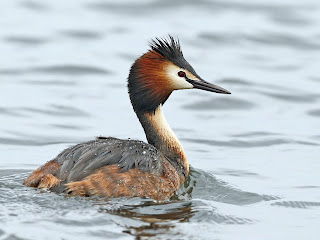Great
Crested Grebe
Podiceps
cristatus
The
great crested grebe is widespread throughout most of Europe except the north, inhabiting
lakes or large ponds with large beds of reeds and rushes. In northern and eastern
parts of the range, birds are migratory, elsewhere resident. They sometimes
return to their breeding grounds as early as February, but more usually in
March or April. An interesting courtship ceremonial takes place: the partners,
separated by several yards, first greet one another by stretching their necks out
along the water’s surface. Then they swim towards each other, spreading their
crests, nodding their heads and finally embracing each other by rubbing necks.
The birds call to each other throughout. Sometimes they dive, surfacing with a
piece of greenery in their bills and treading water face to face with heads
erect. The nest is made of various aquatic plants brought up from the depths.
The female lays three to six eggs which are white at first, but then gradually
acquire a brownish hue. Both partners take turns incubating for 25 to 27 days,
though the female takes the major share. After the nestlings have dried, they
climb onto their parent’s backs and partially conceal themselves under the
wings, so to be carried about even through capable of swimming and diving by
themselves. The parents feed the young small insects and molluscs; adult birds
take mostly insect larvae and fish.
(Migratory, dispersive or resident bird)
Size of egg
|
46.5-62.7X33.0-39.7 mm
|
Length
|
48 cm. Male and female have similar plumage.
|
Voice
|
A deep ‘har-arr’ or ‘er-wick’, mainly during
the courtship period.
|





No comments:
Post a Comment